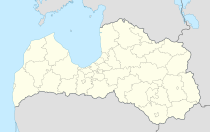Balvi
| Balvi ( German : Bolwen) | ||
|---|---|---|
 |
|
|
| Basic data | ||
| State : |
|
|
| Landscape: | Latgale ( Latvian : Latgale ) | |
| Administrative district : | Balvu novads | |
| Coordinates : | 57 ° 8 ' N , 27 ° 16' E | |
| Residents : | 7,139 (Jan 1, 2016) | |
| Area : | 5.1 km² | |
| Population density : | 1,400 inhabitants per km² | |
| Height : | 118 m | |
| City law: | since 1928 | |
| Website: | www.balvi.lv | |
| Post Code: | ||
| ISO code: | ||
Balvi (German: Bolwen , Russian : Боловск) is a small town located 226 km from Riga (Latvian: Rīga ) in the Latgale region (Latvian: Latgale ) in eastern Latvia .
history
Balvi was first mentioned in 1224 as part of the Riga Archbishopric. The name is derived from the river and lake "Bolupīte". In 1551 the land around the Balvisee was leased to the knight Meißner by the then Riga Archbishop Wilhelm von Brandenburg .
Between 1562 and 1772 the region came under Lithuanian-Polish rule. In 1765 a small wooden church and a manor house were built on the estate of the Polish nobleman Konstancija Hilsena. When Latgale came under Russian sovereignty, the property was transferred to the Yelagin family by Catherine the Great . The Horozhinsky family acquired it in 1806, the Baltic German family Transehe-Roseneck in 1876.
In 1916 the "Riga Latvian Society" was founded here. The first Latgalian Business School was founded here in 1917. After the occupation by Bolshevik troops in 1918, the "Latgallian Partisan Regiment" was founded on July 5, 1919 in Balvi.
After the region "Neulettgallen" ( Lat : Jaunlatgale ) was founded in 1925, the Balvi estate became the village of Balvi in 1926 and the village streets were given street names for the first time. The village received city rights in 1928. This made Balvi the first city in Neulettgallen.
In 1929 the North Latgallian Singing Festival took place in Balvi . In 1936 the Neulettgallen Singing Festival followed.
The city's coat of arms was adopted in 1938.
From July 17, 1940, Balvi was occupied by the Red Army . On June 14, 1941, as in all of Latvia , mass deportations under Russian command took place in Balvi . On July 2, 1941, Balvi was captured by the German Wehrmacht. Many of the city's Jews , who made up around 19% of the population before World War II , were murdered in August 1941 under Walter Stahlecker's reign of terror . The retreating Germans burned Balvi almost completely in 1944. After 1945 the city was rebuilt according to Soviet plans.
In 1948 Balvi hosted the first song festival after the Second World War. Balvi was also a center of the Singing Revolution in 1988 and today plays an important role in preserving Latgalian culture.
Balvu novads
Balvu novads was created in 2009 through a merger with ten surrounding communities. In 2010, 15,597 residents were registered. (see also: Administrative division of Latvia )
Sons and daughters (selection)
- Jānis Bordāns (* 1967), Latvian politician and lawyer
- Arvis Vilkaste (* 1989), Latvian bobsleigh athlete and Olympic champion
literature
- Astrīda Iltnere (Red.): Latvijas pagasti: enciklopēdija. Preses nams, Riga 2002, ISBN 9984-00-436-8 .
